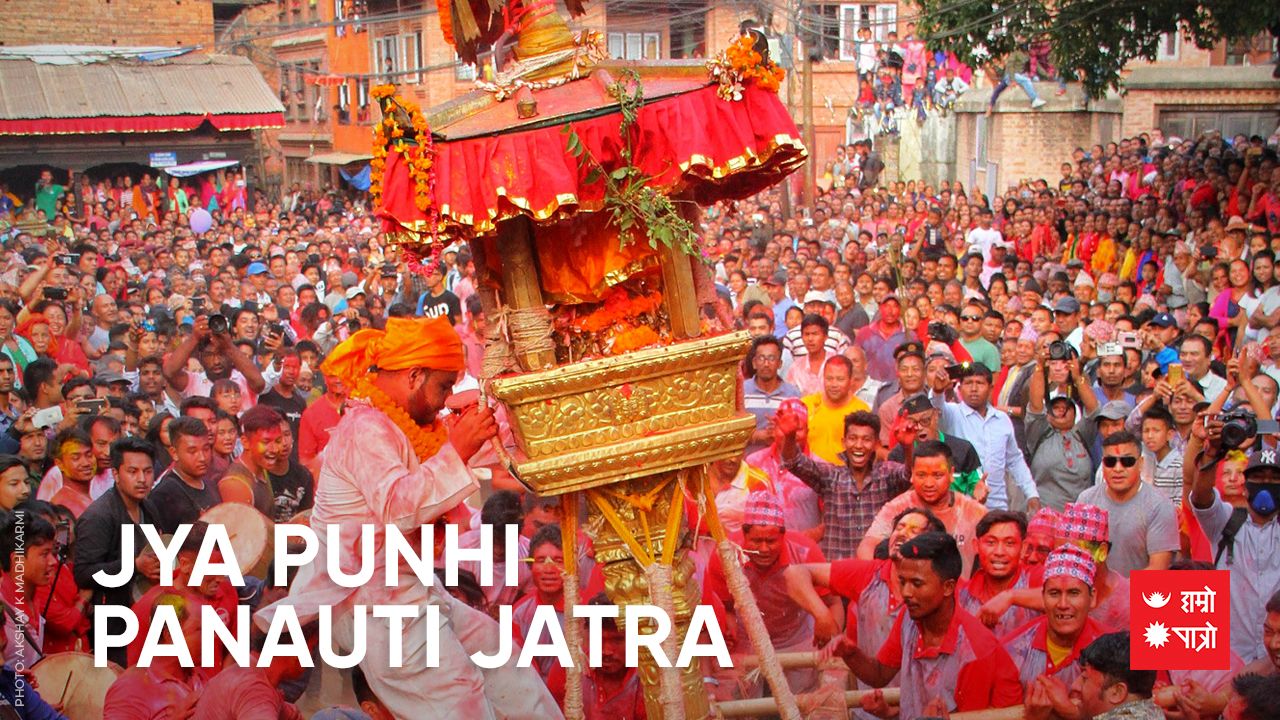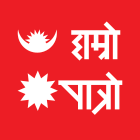Upcomming Events
-
19Mangsir
-
21MangsirInternational Civil Aviation Day 2 days remaning
-
22MangsirInternational Dignified Menstruation Day 3 days remaning
-
23MangsirInternational Anti-corruption Day 4 days remaning
-
24MangsirInternational Human Rights Day 5 days remaning
-
25MangsirInternational Mountain Day 6 days remaning
-
26MangsirGorakhkali Puja/International Day of Neutrality 7 days remaning
-
29MangsirSafala Ekadashi Vrata 10 days remaning
-
1PaushDhanu Sankranti 11 days remaning
-
2PaushPradosh Vrata 12 days remaning
-
3PaushInternational Immigrants Day 13 days remaning
-
5PaushTol Lhosar 15 days remaning
-
6PaushWorld Meditation Day 16 days remaning
-
10PaushChristmas 20 days remaning
-
13PaushGorakhkali Puja 23 days remaning
-
15PaushTamu Lhosar/Kavi Siromani Lekhnath Jayanti/Putrada Ekadashi Vrata 25 days remaning
-
17PaushNew Year 2026/Pradosh Vrata/Topi Day/Poshak Day 27 days remaning
-
19PaushSri Swasthani Vrata Katha Prarambha/Maagh Snan/Poornima Vrata 29 days remaning
-
21PaushGuru Gobinda Singh Jayanti 31 days remaning
-
23PaushAraniko Smriti Day 33 days remaning
-
24PaushNepal Astrology Council Establishment Day 34 days remaning
-
27PaushPrithivi Jayanti/Rashtriya Ekata Diwas/Gorakhkali Puja 37 days remaning
-
29PaushNational Bhakka Day 39 days remaning
-
30PaushShattila Ekadashi 40 days remaning
-
1MaghMakar Sankranti/Ghiu chaku khane Din/Uttarayan Arambha 41 days remaning
-
2MaghNational Earthquake Safety Day/Pradosh Vrata 42 days remaning
-
5MaghSonam Lhochhar/Shree Ballav Jayanti 45 days remaning
-
8MaghTilkunda Chauthi 48 days remaning
-
9MaghBasanta Panchami vrata/Saraswati Pooja 49 days remaning
-
10MaghSkanda Sasti/Achala Saptami/International Day of Education 50 days remaning
-
11MaghGorakhkali Puja/World Leprosy Day 51 days remaning
-
12MaghInternational Custom Day 52 days remaning
-
13MaghDron Nawami 53 days remaning
-
15MaghBhima Ekadashi Vrata 55 days remaning
-
16MaghSahid Diwas/Pradosh Vrata 56 days remaning
-
18MaghShree Swasthani Brata Samapti/Poornima Wrata 58 days remaning
-
19MaghWorld Wetlands Day 59 days remaning
-
21MaghWorld Cancer Day 61 days remaning
-
25MaghRavisaptami Vrata 65 days remaning
-
26MaghGorakhkali Puja 66 days remaning
Jyotish
-
Jyotish Damodar Poudelनेपाल संस्कृत विश्व बिद्यालय�...
-
Jyotish Purushottam Ghimireनेपाल संस्कृत विश्वविद्यालय, �...
-
Jyotish Vaman Sapkotaशिक्षा - व्याकरणाचार्य, पौरोही...
-
 Jyotish Dharmendra Krishna Paudelशास्त्री धर्मेन्द्र कृष्ण पौ�...
Jyotish Dharmendra Krishna Paudelशास्त्री धर्मेन्द्र कृष्ण पौ�...
-
Jyotish Amrit Paudelवाराणसीकै सम्पूर्णानन्द संस्...
-
Jyotish Narayan Prasad Gautamगुरुकुल शिक्षा प्रणालीबाट ज्�...
-
Jyotish Mohan Ghimireसम्पुर्णानन्द संस्कृत विश्वव...
-
Jyotish Narayan Prasad Bhandariज्योतिषका उप-प्राध्यापक (lecturer of A...
-
 Jyotish Mukunda Sharmaस्वाध्याय, सत्सङ्ग र सदाचारजस�...
Jyotish Mukunda Sharmaस्वाध्याय, सत्सङ्ग र सदाचारजस�...
-
Jyotish Smarika Acharyaबाल्मीकि बिद्यापिठ बाट ज्योत�...
-
Jyotish Pandit Mukunda Nepalज्योतिष पण्डित मुकुन्द नेपाल�...
-
 Jyotish Kuresh Pandey११ वर्षको अनुभवसहित विभिन्न ध�...
Jyotish Kuresh Pandey११ वर्षको अनुभवसहित विभिन्न ध�...
-
Jyotish Krishna Prasad Bhandariउपप्राध्यापक (Asst. professor of Sanskrit) नेपा�...
-
Jyotish Deepak Prasad Kafleसम्पूर्णानन्द संस्कृत विश्वव...
-
Jyotish Dipendra Khatiwadaसम्पुर्णानन्द संस्कृत बिश्वब...
-
Jyotish Damodar Kaushikज्योतिष र व्याकरण विषयमा आचार�...
-
Jyotish Khageshwor Subediगुरुकुल पद्दति बाट ज्योतिषीय �...
-
Jyotish Ghanashyam Pokharelनेपाल संस्कृत विश्वविद्यालयब...
-
Acharya Choodamani Pathakसम्पूर्णानन्दसंस्कृत विश्वव�...
-
Jyotish Dr. Janak Bhattaविगत ३५ वर्षदेखि कुण्डली निर्�...
-
Jyotish Khagendra Subediसम्पूर्णानंद संस्कृत विश्ववि...
Jya: Punhi | Panauti Jatra | Poornima Vrat

The eighth month of the Newa calendar is Tachala which coincides with the second month of Bikram Samvat. The full moon begins on the 15th day, starting with the new moon. This month is also divided into Shuklapaksha and Chandrapaksha which are called Tachala Thwa and Tachala Ga.
Now we would like to present here the two great Newa festivals brought by the divine month of Tachla, in which Sithi Nakha falls on the sixth of Shukla Paksha. We have already given the details of this Sithi Nakha. In short, this Sithi Nakha is a festival of water source sanitation, community unity, and worship of Kumar Kartik.
Now let's talk about the day of the full moon which is also called Gaindu Purne. On this day all Hindus and Buddhists celebrate together with joy. For Buddhists, this day is celebrated as Jya Punhi. It is said that Prince Siddhartha left home in search of knowledge on this day.
There are some arguments that Buddha left his wife and son at home when he left home and thus disturbed his wife and son by abandoning domestic life and acquiring tragedy but several Buddhist scriptures acknowledge Yashodhara for her contribution and support to Buddha in his knowledge pursuit. In any case, on this full moon, Gautama Buddha gave up his domestic life to gain knowledge. The importance of this full moon is associated with knowledge and sacrifice, so the Newa community celebrates this full moon with joy. The originality of this pilgrimage is connected with the ancient and holy city of Panauti, 30 km southeast of Kathmandu.
As a tributary of the Roshi, Punyamati, and Padmavati rivers, Panauti is a sacred city in Nepal that has been preserving art and cultural heritages for thousands of years. This Jatra is a fest of mating ritual between Lord Unmata Bhairava and Goddesses Bhadrakali. In this rath yatra, the intercourse analogy between Lord Bhairava and Bhadrakali is depicted and indirectly expressed, so it is customary to do some stages of the rath yatra secretly at night. During the rath yatra, the chariots are taken to different places of the city, and water is sprinkled on the chariots.
It takes 9 days to complete the Archana and Jatra versions of Jya Punhi, therefore the arrival and departure of Punhi last for 9 days. Dashami of Shuklapaksha, the Achanju priest offers sacrifices to the Tantric deities. On this auspicious day, the holy bath in the Punyamati Khola and Roshi Khola, also known as Roshimati are of special importance. This ritual is also called the Panauti bath.
We want to tell a little legend when the river Punyamati was flooded many years ago and the priest had to cross the river to worship Brahmani and Bhadrakali. At the same time, the story of the priest crossing the river with the help of Vasuki Nag is heard throughout the procession.
This year's Jya Punhi or Panauti Punhi or Gaihu Purne, whatever you say, best wishes for this Purne. May the calm, civilized, positive, and inspiring energy always move in our life like the full moon of Shukla paksha. This is a year of adversity and uncertainty, COVID19 Pandemic has an immense impact on our culture, festivals, and congregations. The Panauti Jatra is canceled, construction of chariots will now happen in the coming years, those historic woods of chariots have golden memories, utmost wishes, and desires for god grace.
Poornima Vrat
The last day of Shukla Paksha is the full moon day. On this tithi, the moon is the brightest and magnificent. It is believed that fasting on this day brings immense lunar grace to health, prosperity, and peace. On the full moon day, Lord Shiva and Vishnu are especially worshiped. Special worship to Lord Vishnu is done in the form of Satya Narayan Puja. Satya Narayan Puja is usually performed whenever possible, although the fruits of this puja performed on the day of the full moon are very abundant.
From a scientific point of view, it is said that gravity will have a great effect on the earth on the day of the full moon and self-purification will be done by fasting on this day and remembering the name of God. By fasting on this day, the metabolic process will be strengthened, gastric problems will be solved and positive energy will increase in the body.
This day is fasted from sunrise in the morning to moonrise in the evening. Some people observe this fast without drinking water, while others observe this fast by eating only one meal and eating no salt (alino) food. In the evening, after the moonrise, the fast ends with the sighting of the moon. Happy Jestha Shukla Purnima to everyone this year.
Let there be an end to the flood and landslide, let there be the protection of both religion and the followers of religion.
Suyog Dhakal
Upcomming Events
-
19Mangsir
-
21MangsirInternational Civil Aviation Day 2 days remaning
-
22MangsirInternational Dignified Menstruation Day 3 days remaning
-
23MangsirInternational Anti-corruption Day 4 days remaning
-
24MangsirInternational Human Rights Day 5 days remaning
-
25MangsirInternational Mountain Day 6 days remaning
-
26MangsirGorakhkali Puja/International Day of Neutrality 7 days remaning
-
29MangsirSafala Ekadashi Vrata 10 days remaning
-
1PaushDhanu Sankranti 11 days remaning
-
2PaushPradosh Vrata 12 days remaning
-
3PaushInternational Immigrants Day 13 days remaning
-
5PaushTol Lhosar 15 days remaning
-
6PaushWorld Meditation Day 16 days remaning
-
10PaushChristmas 20 days remaning
-
13PaushGorakhkali Puja 23 days remaning
-
15PaushTamu Lhosar/Kavi Siromani Lekhnath Jayanti/Putrada Ekadashi Vrata 25 days remaning
-
17PaushNew Year 2026/Pradosh Vrata/Topi Day/Poshak Day 27 days remaning
-
19PaushSri Swasthani Vrata Katha Prarambha/Maagh Snan/Poornima Vrata 29 days remaning
-
21PaushGuru Gobinda Singh Jayanti 31 days remaning
-
23PaushAraniko Smriti Day 33 days remaning
-
24PaushNepal Astrology Council Establishment Day 34 days remaning
-
27PaushPrithivi Jayanti/Rashtriya Ekata Diwas/Gorakhkali Puja 37 days remaning
-
29PaushNational Bhakka Day 39 days remaning
-
30PaushShattila Ekadashi 40 days remaning
-
1MaghMakar Sankranti/Ghiu chaku khane Din/Uttarayan Arambha 41 days remaning
-
2MaghNational Earthquake Safety Day/Pradosh Vrata 42 days remaning
-
5MaghSonam Lhochhar/Shree Ballav Jayanti 45 days remaning
-
8MaghTilkunda Chauthi 48 days remaning
-
9MaghBasanta Panchami vrata/Saraswati Pooja 49 days remaning
-
10MaghSkanda Sasti/Achala Saptami/International Day of Education 50 days remaning
-
11MaghGorakhkali Puja/World Leprosy Day 51 days remaning
-
12MaghInternational Custom Day 52 days remaning
-
13MaghDron Nawami 53 days remaning
-
15MaghBhima Ekadashi Vrata 55 days remaning
-
16MaghSahid Diwas/Pradosh Vrata 56 days remaning
-
18MaghShree Swasthani Brata Samapti/Poornima Wrata 58 days remaning
-
19MaghWorld Wetlands Day 59 days remaning
-
21MaghWorld Cancer Day 61 days remaning
-
25MaghRavisaptami Vrata 65 days remaning
-
26MaghGorakhkali Puja 66 days remaning
Jyotish
-
Jyotish Damodar Poudelनेपाल संस्कृत विश्व बिद्यालय�...
-
Jyotish Purushottam Ghimireनेपाल संस्कृत विश्वविद्यालय, �...
-
Jyotish Vaman Sapkotaशिक्षा - व्याकरणाचार्य, पौरोही...
-
 Jyotish Dharmendra Krishna Paudelशास्त्री धर्मेन्द्र कृष्ण पौ�...
Jyotish Dharmendra Krishna Paudelशास्त्री धर्मेन्द्र कृष्ण पौ�...
-
Jyotish Amrit Paudelवाराणसीकै सम्पूर्णानन्द संस्...
-
Jyotish Narayan Prasad Gautamगुरुकुल शिक्षा प्रणालीबाट ज्�...
-
Jyotish Mohan Ghimireसम्पुर्णानन्द संस्कृत विश्वव...
-
Jyotish Narayan Prasad Bhandariज्योतिषका उप-प्राध्यापक (lecturer of A...
-
 Jyotish Mukunda Sharmaस्वाध्याय, सत्सङ्ग र सदाचारजस�...
Jyotish Mukunda Sharmaस्वाध्याय, सत्सङ्ग र सदाचारजस�...
-
Jyotish Smarika Acharyaबाल्मीकि बिद्यापिठ बाट ज्योत�...
-
Jyotish Pandit Mukunda Nepalज्योतिष पण्डित मुकुन्द नेपाल�...
-
 Jyotish Kuresh Pandey११ वर्षको अनुभवसहित विभिन्न ध�...
Jyotish Kuresh Pandey११ वर्षको अनुभवसहित विभिन्न ध�...
-
Jyotish Krishna Prasad Bhandariउपप्राध्यापक (Asst. professor of Sanskrit) नेपा�...
-
Jyotish Deepak Prasad Kafleसम्पूर्णानन्द संस्कृत विश्वव...
-
Jyotish Dipendra Khatiwadaसम्पुर्णानन्द संस्कृत बिश्वब...
-
Jyotish Damodar Kaushikज्योतिष र व्याकरण विषयमा आचार�...
-
Jyotish Khageshwor Subediगुरुकुल पद्दति बाट ज्योतिषीय �...
-
Jyotish Ghanashyam Pokharelनेपाल संस्कृत विश्वविद्यालयब...
-
Acharya Choodamani Pathakसम्पूर्णानन्दसंस्कृत विश्वव�...
-
Jyotish Dr. Janak Bhattaविगत ३५ वर्षदेखि कुण्डली निर्�...
-
Jyotish Khagendra Subediसम्पूर्णानंद संस्कृत विश्ववि...
Liked by:




















 Mesh
Mesh Brish
Brish Mithun
Mithun Karkat
Karkat  Singha
Singha  Kanya
Kanya Tula
Tula Brischik
Brischik Dhanu
Dhanu  Makar
Makar  Kumbha
Kumbha Meen
Meen